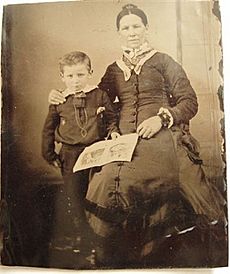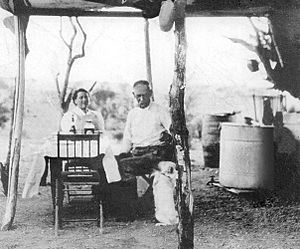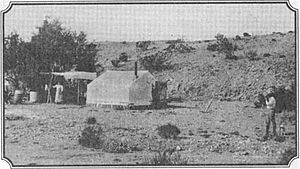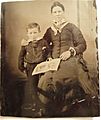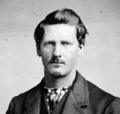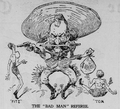Wyatt Earp facts for kids
Quick facts for kids
Wyatt Earp
|
|
|---|---|
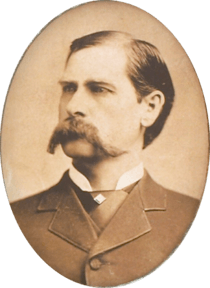
Earp at about age 42.
|
|
| Born |
Wyatt Berry Stapp Earp
March 19, 1848 |
| Died | January 13, 1929 (aged 80) |
| Occupation | Old West lawman, buffalo hunter, saloon owner, bouncer, gold and copper mine owner, boxing referee |
| Years active | 1865–1898 |
| Known for | Gunfight at the O.K. Corral; Fitzsimmons-Sharkey boxing match decision upheld |
| Opponent(s) | William Brocius; Tom and Frank McLaury; Ike and Billy Clanton |
| Spouse(s) | Urilla Sutherland (wife) Sally Heckell (common-law wife?) Celia Ann "Mattie" Blaylock (common-law wife) Josephine Sarah Marcus (common-law wife) |
| Children | None |
| Relatives | Virgil, James, Morgan, Warren (brothers), Newton (half brother), Adelia Earp|Adelia]] sister. |
| Signature | |
 |
|
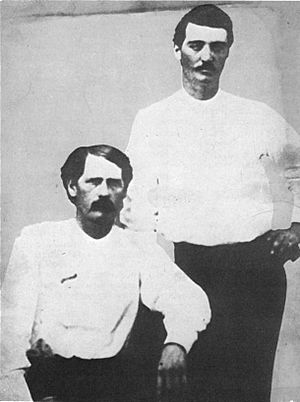
Wyatt Berry Stapp Earp (born March 19, 1848 – died January 13, 1929) was a famous lawman in the American Old West. He worked as a Deputy U.S. Marshal and a Deputy Sheriff. Earp is best known for his part in the Gunfight at the O.K. Corral in Tombstone, Arizona Territory. During this shootout, lawmen stopped a group of outlaws.
Many people think Wyatt Earp was the main person in the Tombstone shootout. However, his brother Virgil was actually the Tombstone City Marshal and a Deputy U.S. Marshal at that time. Virgil had more experience as a sheriff, constable, and soldier.
Contents
Wyatt Earp's Early Life
Wyatt Berry Stapp Earp was born on March 19, 1848. He was the fourth child of Nicholas Porter Earp and his second wife, Virginia Ann Cooksey. He was named after a military officer his father served under in the Mexican–American War. Wyatt's birthplace is believed to be in Monmouth, Illinois. This home is now a historic place.
Wyatt had seven full brothers and sisters: James, Virgil, Martha, Morgan, Warren, Virginia, and Adelia. He also had an older half-brother named Newton.
Moving West
In 1849 or 1850, Wyatt's family planned to move to San Bernardino County, California. They wanted to buy farmland there. But their daughter Martha became sick during the journey. The family stopped in Pella, Iowa, where Nicholas bought a new farm. Sadly, Martha died there in 1856.
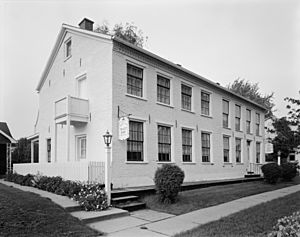
Wyatt's youngest sister, Adelia, was born in Pella in 1861. Three of Wyatt's older brothers, Newton, James, and Virgil, joined the Union Army in November 1861. Their father was busy helping to train soldiers. So, Wyatt, who was only 13, and his two younger brothers, Morgan and Warren, were left to take care of their family's corn farm. Wyatt tried several times to run away and join the army, but his father always brought him home.
James was badly hurt in a battle and came home in 1863. Newton and Virgil fought in many battles and later followed the family to California.
Wyatt Earp's Many Jobs
Wyatt Earp lived a life full of changes and travel. He had many different jobs. He worked as a constable, a city policeman, and a county sheriff. He was also a Deputy U.S. Marshal.
Outside of law enforcement, he worked as a teamster (someone who drives a team of animals), a buffalo hunter, and a saloon-owner. He was also a gambler, a mine owner, a bouncer, and even a boxing referee.
Becoming a Lawman
In 1874, Earp moved to Wichita, Kansas, which was a growing town for cattle. He became a deputy city marshal there for a year. He earned a good reputation as a lawman. In 1876, he moved to Dodge City, Kansas, where his brother James lived. There, Wyatt became an assistant city marshal.
In the winter of 1878, he traveled to Texas to gamble. There, he met John Henry "Doc" Holliday. Earp later said that Holliday saved his life.
Life in Tombstone
Earp often moved from one boomtown to another. In 1879, he left Dodge City and moved to Tombstone with his brothers James and Virgil. Tombstone was experiencing a "silver boom," meaning many people were finding silver there. The Earps bought a share in a mine and some water rights.
Wyatt, Virgil, and their younger brother Morgan all held different law enforcement jobs in Tombstone. This led to problems with a group of outlaws, including Tom and Frank McLaury, and Ike and Billy Clanton. These outlaws threatened to kill the Earp brothers.
The problems grew worse over the next year. It all ended on October 26, 1881, with the Gunfight at the O.K. Corral. In this famous gunfight, the Earps and Doc Holliday killed three of the "Cowboys" (the outlaw group).
After the gunfight, things remained dangerous. In the next five months, Virgil was ambushed and badly hurt. Morgan was killed. Wyatt, his brother Warren, Doc Holliday, and others then formed a group to find those responsible. They killed three of the Cowboys they believed were involved. Wyatt was never hurt in any of these gunfights. This added to his legend after he died.
Wyatt Earp's Legacy
After Wyatt Earp died in 1929, a book was published about him in 1931. This book was very popular, but it made up many parts of his life. It made him famous as a brave lawman. Since then, Wyatt Earp has been shown in many films, TV shows, and books. These stories have made him even more famous.
Today, Wyatt Earp is seen as one of the "toughest and deadliest gunmen" of the Old West. He is a symbol of frontier justice in America.
Two years before he died, Earp talked about his actions in Tombstone. He said he had no regrets about what he did. He believed he did the right thing to stop crime in the area.
Later Life in Los Angeles
In 1910, when Wyatt was 62, the Los Angeles Police Department hired him. He worked with a former detective named Arthur Moore King. They were paid to do special tasks, like bringing criminals back from Mexico. Wyatt was very good at this job.
The Earps bought a small house in Vidal, California. This was the only home they ever owned. While living in Los Angeles, Earp also helped as a consultant for silent cowboy movies.
Wyatt Earp's Death
Wyatt Earp died at his rented home in Los Angeles on January 13, 1929. He was 80 years old. News reports said he had been sick with liver disease for three years. He had no children. He was survived by his wife, Josephine, and his sister, Adelia.
What Wyatt Earp Looked Like
Wyatt Earp was tall, like his brothers. He was about 6 feet (1.8 meters) tall, which was taller than the average person at the time. In 1887, a newspaper described him as "quiet, unassuming, broad-shouldered, with a large blonde mustache." It also said he was "dignified, self-contained, game and fearless."
He weighed about 165 to 170 pounds (75-77 kg). He had long arms and strong muscles. He was very good at using his fists to control people who resisted him, instead of always using his weapon.
Another newspaper described him in detail:
Wyatt Earp, a man whose trigger finger had considerable to do in making the border history of the West, was in Denver for several days last week. He is tall and athletic. His eyes are blue and fringed with light lashes and set beneath blonde eyebrows. His hair, which was once as yellow as gold, is beginning to be stranded with white. A heavy, tawny mustache shades his firm mouth and sweeps below his strong, square chin. He wore... a neat gray tailor-made suit, immaculate linen and fashionable neckwear. With a Derby hat and a pair of tan shoes, he was a figure to catch a lady's eye...
Images for kids
-
Earp's boyhood home in Pella, Iowa.
-
Wyatt Earp (left) in Nome, Alaska, with long-time friend and former Tombstone mayor and newspaper editor John Clum (right), 1900.
See also
 In Spanish: Wyatt Earp para niños
In Spanish: Wyatt Earp para niños



